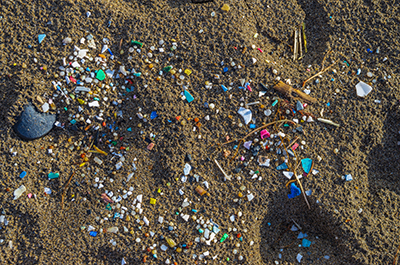What Are Microplastics?
Can Microplastics Be Controlled?
Merriam-Webster defines microplastics as very small pieces of plastic especially when occurring as an environmental pollutant. Others add to the definition saying these are often so small they are invisible to the naked eye. The plastics most commonly used, especially single-use plastics, degrade by heat, UV light, oxidation, and mechanical actions. In addition, biodegradation occurs by living organisms like bacteria. As these materials degrade, they flake away into increasingly small particles that we call microplastics.
Beaches are prime locations of intense heat and sunlight. Humans love going to the beach and humans create waste.  Unfortunately, when the waste remains on the beaches, the hot sun beats down on the sand and the plastic trash becomes brittle. It begins to break down and fall into pieces. The tide rolls in and the garbage goes out. The tide comes in again and the garbage floats back onto the beach. This repeated action over time continues to weaken the plastics and eventually the garbage is reduced to microscopic size, creating numerous environmental concerns. It is these coastal waters and nearby ecosystems that serve as a point of entry for microplastics into the ocean. They become embedded in reefs and marshes disturbing the natural environment. Microplastics are in nearly every part of our environment from oceans, rivers, sediments, ice and more. Although they begin on land they are carried by wind and water. Once in the oceans low concentrations of pesticides floating in the waters attach to these tiny particles. Marine animals mistake microplastics for food, inadvertently digesting pesticides. Also absorbed by marine life are leached monomers resulting from the degrading plastic. Still another concern is the fact that small organisms find the surface of microplastics, which become a form of transportation. The organisms find the surface of microplastics sufficient to colonize and then they travel beyond what is common territory, possibly spreading disease.
Unfortunately, when the waste remains on the beaches, the hot sun beats down on the sand and the plastic trash becomes brittle. It begins to break down and fall into pieces. The tide rolls in and the garbage goes out. The tide comes in again and the garbage floats back onto the beach. This repeated action over time continues to weaken the plastics and eventually the garbage is reduced to microscopic size, creating numerous environmental concerns. It is these coastal waters and nearby ecosystems that serve as a point of entry for microplastics into the ocean. They become embedded in reefs and marshes disturbing the natural environment. Microplastics are in nearly every part of our environment from oceans, rivers, sediments, ice and more. Although they begin on land they are carried by wind and water. Once in the oceans low concentrations of pesticides floating in the waters attach to these tiny particles. Marine animals mistake microplastics for food, inadvertently digesting pesticides. Also absorbed by marine life are leached monomers resulting from the degrading plastic. Still another concern is the fact that small organisms find the surface of microplastics, which become a form of transportation. The organisms find the surface of microplastics sufficient to colonize and then they travel beyond what is common territory, possibly spreading disease.
Microplastics can also result from traditional recycling processes. One phase of the recycling process cuts or chops the collected items into manageable pieces. They are further sorted, shredded, and melted. During these steps, the plastic is washed over and over, flaking off microplastic particles into the wastewater.
 All humans should have pause for concern. Humans consume fish and other seafood that have been affected by the toxic pollutants in the water. This can lead to illness or damage of human cells or more.
All humans should have pause for concern. Humans consume fish and other seafood that have been affected by the toxic pollutants in the water. This can lead to illness or damage of human cells or more.
Additionally, there is risk of economic loss at commercial fisheries due to this endangered food source. Local tourism also suffers as travelers are willing to leave local beaches in search of cleaner beaches, even if it means spending more money. Hitting the personal wallet of individual consumers creates frustrations.
Ongoing efforts designed to prevent the formation of microplastics are directed at waste cleanup. Removing the trashed plastics before they have time to disintegrate into microplastics is viewed as one solution. One mass cleanup effort is The Ocean Cleanup Project, which is well worth reading about as their goal is to cleanup 90% of floating ocean pollution! An innovative development by a very young scientist has promise, and the general concept is demonstrated in this link. Microbiologists found a sustainable method to remove microplastics pollutions. Bacteria sticks together and to surfaces. Researchers want to create “tape-like microbe nets” to drag through polluted waters. The blob-like collection could be safely disposed of or recycled.
In our homes we can assist in the prevention of microplastics when laundering. It is estimated that 35% of all ocean microplastics comes from washing clothes. Synthetic textiles break off as they tumble through wash cycles. There are some rudimentary products for filtering this type of microfiber, but a practical and effective filtering system design would be more beneficial.

Still, the question remains as to defining the actual problem. Are plastics really the problem? Plastics are so very beneficial to our daily lives, sometimes in critical (medical) circumstances and sometimes in ordinary daily routines. It seems the heart of the problem is the lack of humans understanding the full impact of the disposal of the trash they create. No matter how you call it, as humans, we must pull together to better manage our choices. It can begin with individual action, which as we’ve seen from the initial stages of recycling, can progress to develop solutions that will last through the ages, and preserve our planet.
Microplastic Solutions That Might Help Solve Our Plastic Problem (greenmatters.com)
Scientists find way to remove polluting microplastics with bacteria | Microbiology | The Guardian

